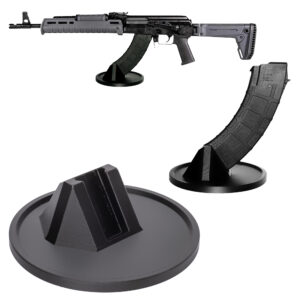
Categories:
The AR-15 rifle, originally developed by Eugene Stoner in the 1950s, has a rich history and has played a significant role in law enforcement agencies across the United States. Initially designed as a military weapon, it quickly gained popularity within civilian law enforcement due to its reliability, accuracy, and versatility. In the late 1960s, police departments began recognizing the potential of AR-15 rifles as a valuable tool for their officers.
The lightweight design allowed for easy maneuverability in urban environments while providing increased firepower compared to traditional handguns or shotguns. As a result, many departments started adopting these rifles to enhance their capabilities in responding to high-risk situations. Over time, advancements in technology led to the evolution of AR-15 variants specifically tailored for law enforcement use. These modifications included the addition of optics such as red dot sights and holographic sights, which improved target acquisition and accuracy.
Additionally, accessories like tactical lights and foregrips were incorporated to enhance operational effectiveness during low-light conditions or close-quarters engagements. However, it wasn’t until the mid-1990s that AR-15 rifles truly became ubiquitous among law enforcement agencies across the country. The Federal Assault Weapons Ban imposed during this period restricted civilian access to certain features commonly found on these guns but exempted law enforcement agencies from these restrictions.
This exemption further solidified their position as an essential tool for specialized units such as SWAT teams responding to active shooter incidents or hostage situations.
As police departments evaluate the role of AR-15s in law enforcement, it is crucial to consider both their advantages and disadvantages. These semi-automatic rifles possess unique features that can enhance operational capabilities, but they also raise concerns regarding safety and public perception. One of the primary advantages of AR-15s is their versatility. These rifles are highly customizable, allowing officers to adapt them for specific situations.
Accessories such as scopes, flashlights, and grips can be easily attached, enhancing accuracy and target acquisition in low-light environments. Moreover, the ability to fire rapidly with minimal recoil provides officers with an advantage when confronting armed suspects or engaging in active shooter scenarios. Another advantage lies in the ammunition capacity of AR-15s. The standard magazine holds 30 rounds, enabling officers to engage multiple threats without frequent reloading.
In high-risk situations where officers face heavily armed suspects or engage in prolonged standoffs, this increased firepower can be essential for maintaining officer safety. However, alongside these advantages come several important disadvantages that must be considered. One concern revolves around public perception and community trust. The appearance of militarization associated with AR-15s may contribute to a perceived disconnect between law enforcement agencies and the communities they serve.
Critics argue that these weapons may escalate tensions during protests or routine interactions with citizens. Furthermore, there are concerns about weapon handling skills among officers using AR-15s. Proper training is crucial for safe gun usage; however, ensuring all officers receive thorough training on handling these rifles presents logistical challenges for police departments already facing budget constraints.
As law enforcement agencies continue to adopt the use of AR-15 rifles, it is crucial to establish comprehensive training and qualification requirements for officers handling these guns. The complexity and power of AR-15s demand a thorough understanding of their operation, as well as the ability to effectively utilize them in various scenarios. To ensure officer safety and public trust, rigorous training programs are necessary.
Firstly, officers must undergo extensive classroom instruction on the mechanics, components, and safe handling procedures specific to AR-15 rifles. This includes detailed explanations of how each part functions and proper maintenance techniques. Understanding the weapon thoroughly is a fundamental step towards safe usage. Additionally, practical training should be conducted in realistic scenarios that simulate encounters where an officer may need to deploy an AR-15 effectively.
These simulations should focus on decision-making skills, target acquisition, accuracy under stress, rapid reloads, and transitioning between different shooting positions. By practicing these skills regularly under controlled conditions, officers can develop muscle memory and enhance their ability to respond swiftly in high-pressure situations. Moreover, marksmanship training should be a key component of any qualification program. Officers must demonstrate proficiency in accurately engaging targets at various distances while considering factors such as windage and bullet drop.
Regular range sessions are crucial for maintaining this skillset over time. Ongoing education is also vital for law enforcement officers using AR-15s. Refresher courses should be provided periodically to reinforce knowledge on gun safety protocols and address any updates or advancements related to the weapon platform.
Law enforcement agencies across the United States have increasingly relied on AR-15 rifles to respond effectively to critical incidents. The utilization of these guns has proven instrumental in several high-stakes situations, where officers were required to neutralize threats while minimizing harm to innocent civilians. This section examines notable case studies that highlight the successful use of AR-15s by law enforcement. In 2013, the Boston Marathon bombing triggered a massive manhunt for the suspects.
During this operation, law enforcement officers encountered Tamerlan and Dzhokhar Tsarnaev, who engaged them in a fierce firefight. The responding officers armed with AR-15 rifles provided a significant advantage due to their superior accuracy and firepower. Ultimately, this enabled them to neutralize the threat swiftly and protect themselves and others from harm. Similarly, in 2015, San Bernardino experienced a horrific terrorist attack at a social services center.
Responding officers confronted heavily armed assailants who posed an immediate danger to countless innocent lives. Equipped with AR-15 rifles, law enforcement quickly established perimeter control and engaged the attackers effectively, preventing further casualties and ultimately eliminating the threat. Additionally, during active shooter incidents such as those at Columbine High School in 1999 or Sandy Hook Elementary School in 2012, law enforcement’s swift response with AR-15s allowed them to engage perpetrators from a distance while minimizing risk to themselves and potential victims.
The use of AR-15 rifles by law enforcement agencies has been a subject of intense public debate and scrutiny. While some argue that these weapons are necessary tools for ensuring public safety, others question their deployment and the potential risks they pose to civilians. This controversy stems from several factors, including misconceptions about the rifle’s capabilities, concerns over militarization of the police force, and incidents involving misuse or excessive force.
One major issue contributing to public perception is a lack of understanding about AR-15s. Often wrongly associated with military-grade assault rifles, the AR-15 is actually a semi-automatic rifle commonly used by civilians for recreational shooting and self-defense. However, its menacing appearance and high-capacity magazines have led to widespread misconceptions that it is inherently dangerous. Critics argue that the use of AR-15s by police contributes to the militarization of law enforcement agencies.
The presence of these rifles during protests or other civil unrest can create an intimidating atmosphere, further straining community-police relations. Concerns have also been raised regarding potential misuse or excessive force when officers deploy these weapons in situations where their use may not be warranted. Incidents involving police use of AR-15s have fueled controversies surrounding their deployment. High-profile cases such as the 2014 Ferguson protests in Missouri highlighted how these weapons can escalate tensions and result in tragic outcomes.
These incidents have led to calls for stricter regulations on their use or even complete disarmament.
The use of AR-15 rifles by law enforcement agencies is subject to a complex framework of laws, policies, and regulations that aim to balance the need for effective crime control with public safety concerns. These legal considerations play a crucial role in determining the conditions under which law enforcement officers can deploy AR-15s. At the federal level, the possession and use of AR-15s by law enforcement agencies are generally permitted under the National Guns Act (NFA) and the Gun Control Act (GCA).
These acts establish guidelines for gun acquisition, registration, transfer, and possession. They outline specific criteria for lawful ownership and require adherence to licensing requirements. However, federal regulations may vary depending on state or local laws. State laws also significantly influence AR-15 use in law enforcement. Some states have enacted stricter gun control measures than those imposed at the federal level, imposing additional restrictions on gun acquisition and possession.
Consequently, law enforcement agencies operating within these jurisdictions must adhere to both federal and state guidelines when using AR-15s. Moreover, individual police departments typically establish their own policies regarding AR-15 deployment. These policies often address issues such as training requirements for officers authorized to use these weapons, circumstances where their use is authorized or prohibited, reporting protocols following their deployment or discharge during an operation or incident response.
To ensure compliance with legal frameworks governing AR-15 use in law enforcement activities while safeguarding public safety interests requires comprehensive training programs that educate officers about relevant laws and policies.
Law enforcement agencies recognize the importance of equipping their officers with the necessary gear to effectively utilize AR-15 rifles in their line of duty. The right equipment and accessories can enhance officer safety, accuracy, and overall operational effectiveness. This subtopic explores some optimal gear options that law enforcement agencies should consider when deploying AR-15s. First and foremost, a reliable optic is crucial for law enforcement officers utilizing AR-15s.
A high-quality red dot sight or holographic sight enables quick target acquisition and improved accuracy in various shooting scenarios. These optics provide a clear sight picture while allowing officers to maintain situational awareness. Another essential accessory is a tactical light mounted on the rifle’s forend or handguard. These lights offer increased visibility in low-light environments, enabling officers to identify potential threats more efficiently.
Furthermore, they can be used as a non-lethal tool by disorienting suspects with a bright beam of light. To enhance control and stability, law enforcement officers should utilize an angled foregrip or vertical grip on their AR-15 rifles. These grips allow for better weapon manipulation during dynamic situations such as room clearing or engaging multiple targets. Additionally, officers should equip their rifles with a reliable sling system.
A well-designed sling enables officers to securely carry their weapon while keeping both hands free when necessary. This facilitates transitioning between different shooting positions and allows for easy access to other tools or equipment. Lastly, it is essential for law enforcement agencies to provide adequate training on all equipment and accessories mentioned above.
As law enforcement agencies continue to adapt to evolving threats and technologies, the role of AR-15 rifles in policing is likely to undergo several changes, innovations, and challenges in the future. While these guns have proven effective for certain situations, there are ongoing discussions on how they can be better utilized while addressing concerns surrounding their use. One potential change that may occur is increased emphasis on specialized training for officers who carry AR-15s.
As these rifles become more prevalent in law enforcement arsenals, ensuring officers receive comprehensive training on their proper use and tactics specific to these weapons will be crucial. This could involve incorporating scenario-based training exercises that simulate real-life encounters where AR-15s may be necessary. Moreover, advancements in technology may also play a role in shaping the future of AR-15 deployment. Enhanced optics and accessories designed specifically for law enforcement use could improve accuracy and overall effectiveness.
Additionally, improvements in non-lethal alternatives or attachments that can be mounted onto AR-15 platforms might provide officers with more options when dealing with situations where lethal force may not be required. However, along with potential changes and innovations come challenges that must be addressed. One such challenge revolves around public perception and concerns over militarization of police forces. Striking a balance between equipping officers with necessary tools without alienating communities is essential.
Furthermore, policymakers will face decisions regarding regulations surrounding the acquisition and use of AR-15 rifles by law enforcement agencies.








Colt
Colt M4 Carbine
Colt LE6920
Colt AR-15 A4
Daniel Defense
DDM4 V7
DDM4 V9
DDM4 V11
DDM4 ISR (Integrally Suppressed Rifle)
Smith & Wesson (S&W)
M&P15 Sport II
M&P15 Tactical
M&P15T
Bravo Company Manufacturing (BCM)
BCM Recce-16
BCM Recce-14
BCM MCMR Series
Aero Precision
M4E1 Series
AC-15
AR15 Pistol (Various Configurations)
Ruger
Ruger AR-556
Ruger SR-556
Ruger AR-556 MPR (Multi-Purpose Rifle)
Springfield Armory
Saint Victor
Saint Edge
Saint AR-15
PSA (Palmetto State Armory)
PSA PA-15
PSA AR-V
PSA Jakl (AR Pistol)
FN America
FN 15 Tactical Carbine
FN 15 Patrol
FN 15 DMR
Wilson Combat
Recon Tactical
Super Sniper
Protector Carbine
SIG Sauer
SIG M400 Tread
SIG M400 Elite
SIG M400 SDI
LWRC International
IC DI (Direct Impingement)
IC SPR
IC A5
Bushmaster Guns
XM-15 QRC
Bushmaster MOE
XM-15 Patrolman
Rock River Arms
LAR-15 Entry Tactical
LAR-15 Predator
LAR-15 Elite Comp
Stag Arms
Stag 15 Tactical
Stag 15L (Left-Handed Models)
Stag 15 Valkyrie
Noveske Rifleworks
Noveske Gen 4 N4
Noveske Space Invader (AR Pistol)
Noveske Recon
Anderson Manufacturing
AM-15 Optic Ready
AM-15 M4 Carbine
AM-15 Precision Rifle
Adams Arms
AA-15 Piston Rifle
P2 AARS (Adams Arms Rifle Series)
Black Rain Ordnance
SPEC15 Series
BRO Predator
Fallout 15
Diamondback Guns
DB15 Series
DB15CCMLB
DB15EB
Del-Ton Inc.
DTI-15
Del-Ton Echo 316H
Sierra 316M
Windham Weaponry
Windham SRC
Windham VEX-SS
Windham RMCS-4 (Caliber Conversion System)
Christensen Arms
CA-15 G2
CA-15 Recon
CA-15 Titanium Edition
Patriot Ordnance Factory (POF-USA)
Renegade Plus
P415 Edge
Revolution DI
LaRue Tactical
PredatAR
OBR (Optimized Battle Rifle)
LaRue Stealth 2.0
Battle Arms Development
Workhorse Patrol Carbine
BAD556-LW (Lightweight)
Authority Elite Rifle
Faxon Guns
Ascent AR-15
FX-19 (AR Pistol)
Streamline Ultralight Series
KE Arms
KE-15 SLT (Super Lightweight Tactical)
KE-15 Scout Carbine
Primary Weapons Systems (PWS)
MK1 MOD 2-M
MK116 PRO
MK107 (Piston AR Pistol)
ZEV Technologies
ZEV Core Elite Rifle
ZEV AR15 Billet Rifles
Franklin Armory
BFSIII AR-C1
Militia Model
F17-L (Chambered in .17 WSM)
Seekins Precision
SP15 DMR
NX15 Skeletonized Rifle
Havak Bravo
Aero Precision (Additional Models)
EPC-9 (Pistol Caliber ARs)
VG6 AR Rifles
Barrett Guns
REC7 DI
REC7 Gen II
CMMG
MK4 RCE
Resolute 300
Banshee (AR Pistol)
DPMS Panther Arms
Panther Oracle
Panther LR-308
H&K (Heckler & Koch)
HK MR556A1
HK416 (Military Variant)
Rock Island Armory (Armscor)
VR-80 Tactical AR (Shotgun AR Platform)
Troy Industries
Troy SPC-A3
Troy PAR (Pump Action AR)
Wilson Tactical
Tactical Recon AR
Protector Series
F1 Guns
FDR-15 Skeletonized Rifle
BDRx-15 Series
Juggernaut Tactical
JT-15
JT-10 Precision Rifle
AeroSurplus
Surplus AR-15 Rifles (Budget Models)
Thunder Tactical
AR-15 Basic Carbine
Tactical Builder Sets
Radical Guns
RF-15
Forged AR-Series
Dark Storm Industries
DS-15 Featureless Rifles
DS-10 Typhoon
DRD Tactical
Paratus
Aptus AR Rifles
Bear Creek Arsenal
BCA-15
AR Complete Upper Builds
Aero Survival Rifles (ASI)
ASR Tactical Series
Tactical Edge
WARFIGHTER Series
AR-15 Lightweight Rifles
Lone Star Armory
TX15 DMR
TX15 Carbine
HERA Arms
HERA H7
HERA AR-15 Lower Builds
IWI (Israeli Weapon Industries)
Zion-15
DRD Tactical
Tactical Modular Rifles
Quick-Takedown Rifles
V Seven Weapons
1776 Rifle
Hyperlite Rifle
Core Rifle Systems
Core15 Tac III
Core15 Patrol Rifle
Armalite (Original AR-15 Creator)
M15 Tactical
M15 A4 Carbine
DEF15 (Defensive Sporting Rifle Series)
PSA (Palmetto State Armory Additional Models)
PSAK-47 Hybrid (AR-AK Style Hybrid)
PSA Dagger (Pistol Caliber Configurations)
Odin Works
OTR-15
Odin Recon Rifle
Maxim Defense
MDX-508 PDX (Compact AR Pistol)
MDX-510 Rifle